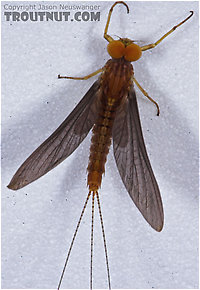Blog & Latest Updates
Fly Fishing Articles
Insects by Common Name


Mayfly Genus Eurylophella (Chocolate Duns)
Taxonomic Navigation -?-
Kingdom
Animalia (Animals)
» Phylum
Arthropoda (Arthropods)
» Class
Insecta (Insects)
» Order
Ephemeroptera (Mayflies)
» Genus Eurylophella (Chocolate Duns)
| Species in Eurylophella | ||
| Eurylophella bicolorChocolate Dun | 0 | 0 |
| Eurylophella funeralisChocolate Dun | 0 | 0 |
| Eurylophella lutulentaChocolate Dun | 0 | 0 |
| Eurylophella temporalisChocolate Dun | 0 | 0 |
10 species aren't included.
Common Name
| Match | Common Name |
| Chocolate Duns |
Where & When
This genus is widespread throughout the East and Midwest but rarely abundant. The few species for which emergence dates are available all emerge in May and June.
Nymph Biology
Current Speed: Slow
These nymphs probably inhabit slow water where the bottom is covered with silt or detritus (Detritus: Small, loose pieces of decaying organic matter underwater.). The operculate (
The operculate gills of a Caenis nymph.
Pictures of 22 Mayfly Specimens in the Genus Eurylophella:
Male Eurylophella (Chocolate Duns) Mayfly Spinner View 10 Pictures
View 10 Pictures
 View 10 Pictures
View 10 PicturesCollected June 4, 2005 from the Teal River in Wisconsin
Added to Troutnut.com by Troutnut on May 24, 2006
Added to Troutnut.com by Troutnut on May 24, 2006
Eurylophella temporalis (Chocolate Dun) Mayfly Nymph View 9 Pictures
View 9 Pictures
 View 9 Pictures
View 9 PicturesCollected June 5, 2005 from the Marengo River in Wisconsin
Added to Troutnut.com by Troutnut on May 25, 2006
Added to Troutnut.com by Troutnut on May 25, 2006
Male Eurylophella (Chocolate Duns) Mayfly Dun View 5 Pictures
View 5 Pictures
 View 5 Pictures
View 5 PicturesCollected June 14, 2005 from the Teal River in Wisconsin
Added to Troutnut.com by Troutnut on May 26, 2006
Added to Troutnut.com by Troutnut on May 26, 2006
Recent Discussions of Eurylophella
florida mayfly nymph imitations 2 Replies »
Posted by Homer47 on Sep 5, 2012 in the species Eurylophella temporalis
Last reply on Sep 6, 2012 by Sayfu
Looks like an imitation would be about a #10 or #8 dark brown nymph pattern. I'm down here in north Fla and trying to match the hatch in the far north central part of the state, mostly to fool the bream. Any ideas or help would be appreciated. I found two patterns so far that seem to work- a little brown nymph with a rusty brown/orange thorax(maybe this is a good representation of the E. Temporalis), and a size 12 buzzer nymph with black body, peacock thorax and white breathing filament. The bream seemed to agree with that choice. I would like to try and copy more local insects as I figure out what they are.There are dragonflies and damselflies and mosquitoes. I could start there.
ReplyYour Thoughts On Eurylophella:
Top 10 Fly Hatches
Top Gift Shop Designs
Eat mayflies.
Top Insect Specimens
Miscellaneous Sites
Troutnut.com is copyright © 2004-2024 Jason
Neuswanger (email Jason). See my FAQ for information about use of my images.
 privacy policy
privacy policy
